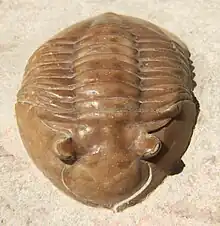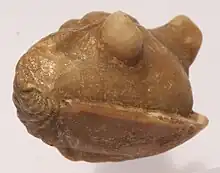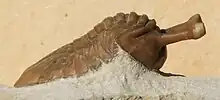| Asaphus Temporal range: | |
|---|---|
 | |
| A. latus | |
| Scientific classification | |
| Domain: | Eukaryota |
| Kingdom: | Animalia |
| Phylum: | Arthropoda |
| Class: | †Trilobita |
| Order: | †Asaphida |
| Family: | †Asaphidae |
| Genus: | †Asaphus Brongniart, 1822[1] |
| Type species | |
| Entomostracites expansus[2] Wahlenberg, [1818][3] | |
| Species | |
| |
Asaphus (/ˈæsæfʌs/) is a genus of trilobites that is known from the Lower (upper Arenig) and Middle Ordovician of northwestern Europe (Sweden, Estonia, Saint Petersburg Area).[4]
Etymology
The generic name is derived from the Greek word asaphes, meaning "indistinct."
Description

The headshield (or cephalon) and tailshield (or pygidium) are semicircular and without a border (defined by a furrow or a change in convexity parallel to its margin). The cephalon is of approximately equal size as the pygidium (or isopygous).
The central raised area of the cephalon (or glabella) is long, reaching the frontal margin. It may have faint lateral glabellar furrows or be smooth, and sometimes an inconspicuous tubercle is present just in front of the hardly discernible occipital ring. The natural fracture lines (sutures) of the head run along the top edges of the compound eye. From the back of the eye these cut to the back of the head (or is said to be opisthoparian) and not to the side. The free cheeks (or librigenae) are separated from each other anteriorly by a suture at the midline. The corner between the side and the back of the cephalon (or genal angle) is rounded or (in a few species) pointed into spines. Eyes holochroal, commonly more or less conical, short or moderate in length. In some evolution lines, the visual surface of the eye is raised on a stalk.
The lateral corners of the palate (or hypostome), visual from the ventral side, are more or less protruding, and the posterior part is forked with two triangular teeth. The reflexed margin of the exoskeleton (or doublure) is broad.
The articulate midlength part of the body (or thorax) consists of 8 segments. Furrows in the parts outside the axis (or pleural furrows) are diagonal.
The pygidium is rounded, and has a long axis with concave, posteriorly parallel sides. Some rings may be faintly defined anteriorly and the axis dissolves in the postaxial field. The areas outside the axis (or pleural fields) are smooth or very faintly ribbed.[5]
Species
- A. expansus (Wahlenberg, [1818])[6] (type species) synonyms Entomostracites expansus, Entomolithus paradoxus α expansus
- A. acuminatus Boeck, 1838
- A. bottnicus Jaanusson
- A. broeggeri Schmidt, 1898
- A. cornutus Pander, 1830
- A. eichwaldi Schmidt
- A. heckeri (Ivantsov)
- A. holmi Schmidt, 1898
- A. ingrianus Jaanusson, 1953
- A. intermedius Lessnikova in Balashova, 1953
- A. knyrkoi Schmidt
- A. kotlukovi Lessnikova in Balashova, 1953
- A. kowalewskii Lawrow, 1856
- A. latus Pander, 1830
- A. laevissimus Schmidt, 1898
- A. lepidurus Neiszkowski, 1859
- A. minor
- A. neiszkowskii Schmidt, 1898
- A. pachyophthalmus
- A. platycephalus (Stokes, 1824) [7]
- A. plautini Schmidt, 1898
- A. punctatus Lessnikova, 1949
- A. raniceps Dalman, 1827
- A. robustus
- A. sulvevi Jaanusson
- A. vicarius (Toernquist, 1884)
- A. wahlenbergi
Species previously assigned to Asaphus

As the genus Asaphus was established early, many species have since been reassigned to genera in various trilobite orders.[8]
- A. angustifrons = Ptychopyge angustifrons
- A. armadillo = Nileus armadillo
- A. aspectans = Coronura aspectans
- A. barrandei = Basilicus barrandei
- A. brongniarti = Eohomalonotus brongniarti
- A. canadensis = Pseudogygites canadensis
- A. cawdori = Acaste cawdori
- A. corndensis = Ogyginus corndensis
- A. debuchii = Ogygiocarella debuchii
- A. devexus = Xenasaphus devexus
- A. duplicatus = Platycalymene duplicatus
- A. eichwaldi = Bollandia eichwaldi[9]
- A. extans = Bathyurus extans
- A. fischeri = Pliomera fischeri
- A. frontalis = Niobe frontalis
- A. gemmuliferus = Phillipsia gemmulifera[9]
- A. globiceps = Bollandia globiceps[9]
- A. granuliferus = Bollandia globiceps[9]
- A. hausmanni = Odontochile hausmanni
- A. homfrayi = Asaphellus homfrayi
- A. latifrons = Stygina latifrons
- A. nasutus = Neoprobolium nasutus
- A. obsoletus = Bollandia obsoleta[9]
- A. palpebrosus = Symphysurus palpebrosus
- A. plicicostis = Plectasaphus plicicostis
- A. praetextus = Ogmasaphus praetextus
- A. selenourus = Odontocephalus selenourus
- A. seminiferus = Eocyphinium seminiferum[9]
- A. seticornis = Tretaspis seticornis
- A. stacyi = Homalopyge stacyi
- A. stokesii = Warburgella stokesii
- A. subcaudatus = Acaste subcaudata
- A. truncatulus = Phillipsia truncatula[9]
- A. tyrannus = Basilicus tyrannus
References
- ↑ Brongiart, Alexandre (1822). "Des corps organisés fossiles nommés trilobites". In Brongniart, Alexandre; Desmarest, Anselme-Gaëtan (eds.). Histoire naturelle des crustacés fossiles. Paris: L.-T. Cellot. pp. 17–25.
- ↑ Jaanusson, Valdar (1956). "Proposed use of the Plenary Powers to suppress the generic name Asaphus as published by Brongniart in Desmarest, 1817, and to designate a type species in harmony with general usage for the genus Asaphus Brongniart, 1822 (Class Trilobita)". The Bulletin of Zoological Nomenclature. 12 (3): 90–96.
- ↑ Wahlenberg, Georgio (1821) [1818]. "Petrificata telluris svecanae". Nova Acta Regiae Societatis Scientiarum Upsaliensis. 8: 25–27.
- ↑ Martin Stein & Jan Bergström (2010). "Some lower Middle Ordovician species of Asaphus (Trilobita) from Sweden". GFF. 132 (2): 105–116. Bibcode:2010GFF...132..105S. doi:10.1080/11035897.2010.486478. S2CID 129705036.
- ↑ Moore, R.C. (1959). Arthropoda I - Arthropoda General Features, Proarthropoda, Euarthropoda General Features, Trilobitomorpha. Treatise on Invertebrate Paleontology. Vol. Part O. Boulder, Colorado/Lawrence, Kansas: Geological Society of America/University of Kansas Press. pp. O334–O436. ISBN 978-0-8137-3015-8.
- ↑ International Commission on Zoological Nomenclature (1982). "Direction 111 - Entomostracites punctatus Wahlenberg (Trilobita) (Official List Of Specific Names No. 1595): Date To Be Cited As [1818]". Bulletin of Zoological Nomenclature. 39.
- ↑ White, Charles Abiathar (1891). The Texan Permian and Its Mesozoic Types of Fossils. United States Geological Survey. p. 28. Retrieved 26 April 2018.
charles stokes fossil.
- ↑ Moore, R.C. (1959). Arthropoda I - Arthropoda General Features, Proarthropoda, Euarthropoda General Features, Trilobitomorpha. Treatise on Invertebrate Paleontology. Vol. Part O. Boulder, Colorado/Lawrence, Kansas: Geological Society of America/University of Kansas Press. pp. O446 and O468. ISBN 978-0-8137-3015-8.
- 1 2 3 4 5 6 7 Osmólska, H. (1970). "Revision of non-cyrtosymbolinid trilobites from the Tournaisian-Namurian of Eurasia". Palaeontologia Polonica. 23.
